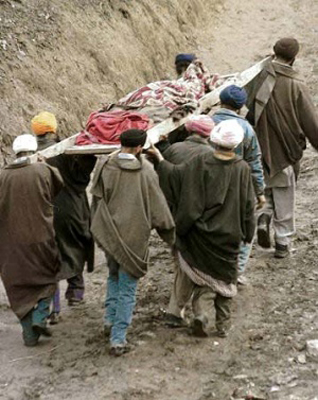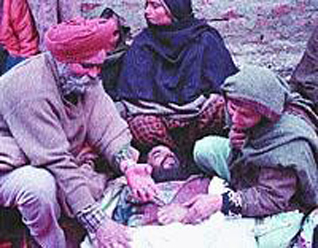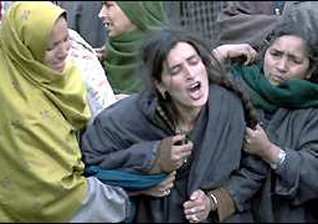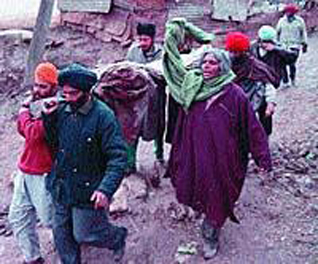History
Indian Army's Staged Massacre of 35 Sikhs in Chattisingpora in 2000, And The Cover-Up
by ANIL BHAT
Knowing that President Clinton's next stop was to be in Pakistan during his whirlwind 2000 tour, Indian "intelligence" staged a masaacre of 35 innocent Sikhs in Chattisingpora, Kashmir, to coincide with his arrival in India. India's media did its usual bit: it immediately blamed it on Pakistani "terrorists". The goal was to create an overwhelming bias against the Pakistanis before the President touched-down on Pakistani soil.
The ruse succeeded. Extraordinary precautions were taken to "protect" Clinton in Pakistan, resulting in his visit to Pakistan being reduced to a few hours - compared to the five days he had in India.
The dead? Mere pawns in India's criminal geopolitik! The real story has remained hidden, but has been coming out slowly but steadily through recent revelations.
The following is yet another chapter revealing the truth. [sikhchic.com]
Former U.S. President Bill Clinton’s visit to India in March 2000 was indeed significant in some aspects and eventful.
While this visit marked a new chapter in India-U.S. relations, it also got marked by the massacre of 35 Sikhs at Chattisinghpora in Kashmir on March 20. Mr Clinton’s visit to Pakistan thereafter stood out for its stark contrast.
Five days in India were followed by six hours in Pakistan, where Mr. Clinton unprecedentedly arrived in Islamabad in an unmarked jet moments after a decoy aircraft carrying his look-alike had landed there. His motorcade from Islamabad airport contained six black limousines, with the cars switching positions once they left the airport.
This was the first known instance of a U.S. President having travelled to another country with the cover of a decoy plane and decoy men, deception measures against any terrorists wanting to assassinate Mr. Clinton.
The
President’s spokespersons said, the elaborate security precautions were
necessitated by the fact that Pakistan harboured terrorists, some of
whom were actually members of the Pakistan military. It was no wonder
that Mr. Clinton did not inspect a guard of honour. Also, no photograph
was allowed showing Mr. Clinton shaking hands with the then Pakistani
dictator Pervez Musharraf, or even a picture of them posing together.
The irony is that while 12 years later the U.S. has no doubts about strong
connections of Pakistan Army and ISI with terrorist organisations, in
India, the Army, which has been combating terrorists supported by
Pakistan’s military for over two decades, is being accused of staging a
fake encounter in an operation it conducted jointly with the police.
A day after the heinous massacre at Chattisinghpora, the Jammu and Kashmir police arrested one suspected terrorist named Mohammad Yaqoob Wagey, who during his interrogation, admitted being part of a militant group which carried it out. He also gave information about the possible hideouts of those militants at Punchalthan area.
That information was
shared by the then SSP Ananatnag with the then Commander, 1 Sector
Rashtriya Rifles (RR), and a joint operation by the RR and police
personnel was launched on March 25, 2000, in which five unidentified
terrorists were killed.
Immediately after the operation, then SSP Anantanag and higher Army
officials visited the site, saw the dead bodies and arms and ammunition
recovered from the terrorists and gave interviews to media.
On March 29, 2000, there was a protest demonstration by local villagers
demanding further investigation of the incident which resulted in chief
judicial magistrate (CJM) Anantnag directing that the bodies be exhumed
for DNA testing. Anantnag police station was asked to register a case
and investigation by a SIT, headed by SSP Anantnag, was launched.
On March 6, 2002, a leading Delhi-based newspaper published a report, “J&K govt fudges DNA samples to cover up civilian killings”.
On March 9, 2002, the J&K government set up a one-man commission by Justice G.A. Kuchaoi to probe the DNA fudging.
After submission of the commission report to the state government, a three-member Cabinet sub-committee under the deputy chief minister was constituted, which recommended that all cases be handed over to CBI. The CBI after its investigation was of the view that the Army unit, i.e., 7 RR, hatched a criminal conspiracy to pick up some persons and to kill them in a fake encounter so that they could be labelled as persons responsible for the Chattisinghpora killings.
Accordingly, the CBI filed a challan (charge-sheet) against
the then CO, three officers and one JCO of 7 RR for their alleged
involvement in the murder and abduction of five civilians in the court
of CJM at Srinagar. No police person was named in the case.
The CJM granted opportunity to the Army to exercise the option of the competent military authority taking over the case under the provisions of Army Act Section 125 for trial by court martial or that the trial be held in criminal court.
The Army authorities filed an application before the court pointing out that no prosecution could be instituted without the previous sanction of the Central government in view of Section 7 of the Armed Forces (J&K) Special Powers Act (AFSPA), 1990 and, therefore, the proceedings may be dropped by returning the chargesheet.
The probe agency filed a reply to the application by Army authorities, wherein it averred that since the alleged act cannot be termed as, “discharge of official duty”, the accused persons are not eligible for protection under Section 7 of the AFSPA (J&K), 1990.
The case,
initially heard in the courts, subsequently came up for hearing in the
Supreme Court based on a special leave petition filed by the Army
challenging the directions of the high court.
The CBI report curiously does not mention the involvement of the police
in the entire episode. The police not only provided the information
based on which the operation was launched, but was active participants
and took credit at the end of the operation, as admitted in statements
of senior police officers. These anomalies raise questions on the CBI
investigation and subsequent filling of a challan in the court of CJM,
Srinagar.
On February 3, 2012, the matter was taken up before the bench of Justice B.S. Chauhan and Justice Swatanter Kumar in the Supreme Court of India.
The additional solicitor-general (ASG) argued that to meet the peculiar conditions of employment of the Armed Forces in the State of J&K, the Parliament has provided a protection in the form of Section 7 of AFSPA which requires that once investigation is done, the matter has to be referred to the Central government to examine whether sanction for the prosecution has to be accorded or not. Thereafter, the ASG pointed out the documents to show that the operation was undertaken by the Rashtriya Rifles Unit, based on intelligence provided by the J&K police and it was a joint operation as per the daily diary entry made by the police.
The operation undertaken is well documented with timely
situation reports and the seizure memos were well documented in
conjunction with civil police. Thus the ASG countered the CBI’s charge
that the Army Unit had stage managed the killing after abducting
innocent civilians.
The court then called upon the senior counsel for CBI, for his
arguments. The CBI counsel relied upon the final report presented by the
CBI to put forward their argument. The court questioned the senior
counsel as to how the arms and ammunition recovered from the scene of
occurrence reached there, the views of CBI on the official situation
reports of the military authorities.
The court then adjourned the case to February 24, 2012, directing the CBI counsel to make submissions on the aforesaid queries and also directed the ASG appearing for Union of India through ministry of defence and ministry of home affairs as to their stand on the issue of prior sanction for the prosecution.
Anil Bhat, a retired Army officer, is a defence and security analyst based in New Delhi
[Courtesy: Asian Age]
February 24, 2012
Conversation about this article
1: Baldev Singh (Bradford, United Kingdom), February 24, 2012, 1:55 PM.
Article after article on sikhchic.com indicts the Indian 'authorities' and their 'political paymasters', who function with complete public agreement, complicity, and/or condonation, to commit summary executions of innocent people ... while shifting the blame on third parties for purely political and sectarian reasons. This is a country where violence is the FIRST resort at every level of society and politics!
2: G.C. Singh (U.S.A.), February 24, 2012, 4:54 PM.
Following is a letter written by Sardar simranjit Singh Mann to the President of India regarding the planned murder of Sikhs by Indian intelligence agencies. Re Chattisinghpura murder of Sikhs : Letter from SAD (A) Qilla S. Harnam Singh, October 7, 2006. In continuation of my letter dated 22.9.2006 addressed to Your Excellency regarding the human right and fundamental right violations of the Sikh peoples in India, I have now come to gather more proof and evidence of the Chattisinghpura mass murders of Sikhs, their families and their children in the Kashmir valley. This massacre or select killings of Sikhs took place in the Kashmir valley in February 2000. I have now come to be informed by my special sources that during that period of time Col. Ajay Saxsena of X Guards, was posted to 7RR which looked after the security arrangements of Anantnag at Tehsil Khundru. Col Saxsena's company commander was Major Shorab Sharma previously from an artillery regiment then posted in 7RR at Rampura, a distance of 3 kilometers from Chattisinghpura where the Sikh massacre took place. Col. Saxsena kept Sikh soldiers from his 7RR regiment as his personal and special guards. They were drawn from soldiers on deputation from the Punjab Regiment and Artillery Regiment which composed his battalion strength of 7RR. By 15th of April 2000, he had dropped all the Sikh guards from his security attachment and brought in Hindus of the Punjab regiment and Artillery on deputation attached to 7RR. The Hindus were Dogras from the Punjab regiment and Hindu Madrasis from the Artillery. The Sikhs attached to Col. Saxsena as guards who were from Punjab regiment and Artillery were sent into the companies of 7RR. It was this new component of Hindu guards of Col. Saxsena, under the command of Major Shorab Sharma, that carried out the ghastly and shameful murder of Sikhs at Chittisinghpura that unfortunate day. After the gruesome and unpatriotic killings of the Sikhs at Chittisinghpura, Col. Saxsena had six Muslims taken off a bus at Ranipura and had them slaughtered in cold blood by his new Hindu guards. They were buried later at Anantnag. This extra-judicial murder of the six Muslims was carried out-(1) to account for and blame them for the Chattisinghpura killings of Sikhs, (2) to sow seeds of enmity between Sikhs and Muslims who were both living in peace and were on amicable and good terms, to prove to the visiting American President, Mr. Clinton of the inhuman civilian killings by Muslim militants. After ten days of the Chattisinghpura Sikh massacre Col. Saxsena recalled the Sikh guards he'd posted out and once again put them back on his personal guard duty. He'd accomplished his task of killing the Sikhs and Muslims and planting the seeds of suspicion and discord amongst the Sikhs and Muslims, and also alarmed President Clinton of the situation in Indian held Kashmir. In August 2000, Colonel Saxsena was posted to Ferozepore as Admin Colonel 65, Brigade. Captain Shorab Sharma, the other perpetrator of this evil crime, remained posted in 7RR till October 2000. Thereafter, like Col. Saxsena, having carried out his macabre task successfully, was posted to Army Head quarters, New Delhi. Had it not been for Mrs. Albright's book which I have written from and quoted former President Clinton, this foul murder of the Sikhs and who were the culprits, would never have come to light. "Obviously Mr. President, Colonel Saxsena could never have carried out this premeditated cold blooded murder of Muslims and Sikhs without orders from his administrative superiors in Srinagar, Udhampore and political and administrative masters in Delhi. Therefore this is a great conspiracy by the Indian state to murder both its major minorities." I, on behalf of the Sikh people, thank the Americans for their centuries old tradition of openness, candour and transparency and leave the ball in your court to order a full CBI investigation, with no holds barred, to examine the then Corp Commander at Srinagar, Army Commander in Udhampore, the then Chief of the Army, former Deputy Prime Minister L.K. Advani and Prime Minister A.B. Vajpayee and of course the then Chief Minister of Jammu and Kashmir Farooq Abdullah and his security personnel. The hand of India's intelligence agencies RAW and IB needs to be thoroughly investigated in this diabolic sectarian and communal murders. I will be grateful. With regards, Yours sincerely, Simranjit Singh Mann, President, Shiromani Akali Dal (Amritsar). To H.E. Mr. A.P.J. Abdul Kalam, Hon'ble President of India, President's House, New Delhi.
3: Ravinder Singh Khalsa (U.S.A.), February 25, 2012, 12:12 PM.
I don't know why we continue to expect justice in India. They won't do justice no matter how many letters we write to the prime minister, president, etc. They're all power hungry, corrupt, murderers, rapists, etc. We Sikhs need to unite and raise our issues at the international level. India is a useless concept, for Sikhs we were better off even under British rule.
4: Gurjender Singh (Maryland. U.S.A.), February 25, 2012, 1:05 PM.
This is happening even when the TV and other media is "free" and "open". This in not like 1984 when the media had been muzzled. Why aren't the S.G.P.C. and D.G.P.C. and other Sikh institutions/leaders raising this issue?
5: Sachin Chaudhry (India), June 13, 2014, 1:39 AM.
Sikhs are the back-bone of the Indian Army and of India as well. I am proud to live in their country. Love you, brothers.
6: Khawaja Atteeq (Kashmir), March 30, 2016, 12:27 AM.
Isn't that the story of every Kashmiri, regardless of his faith or color of his skin or the language of he speaks? We've all suffered from the hands of the occupiers in every aspect of our life, from education to food and from life to unjustified death. That is the awful story of ours.






